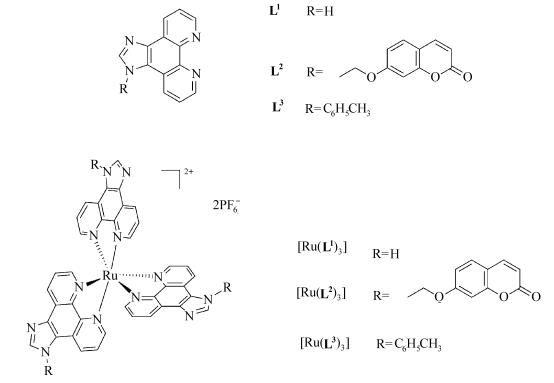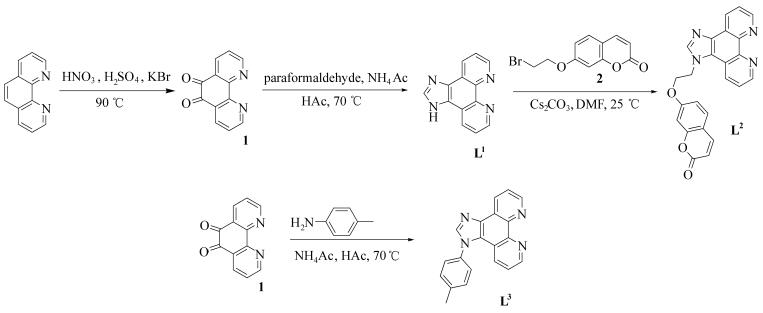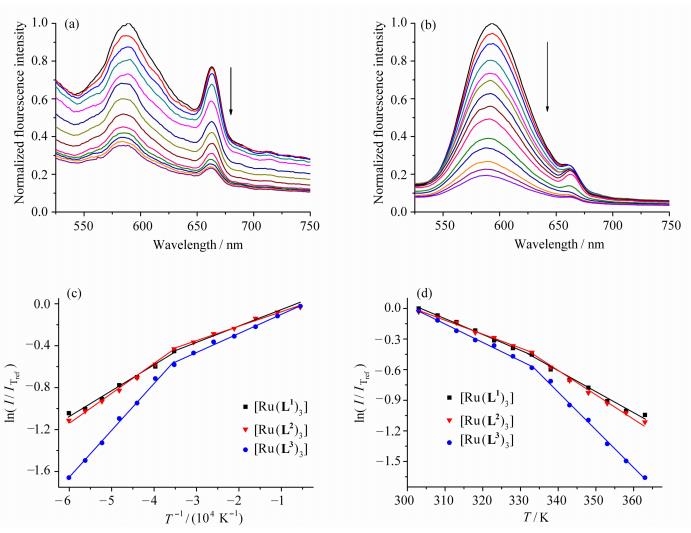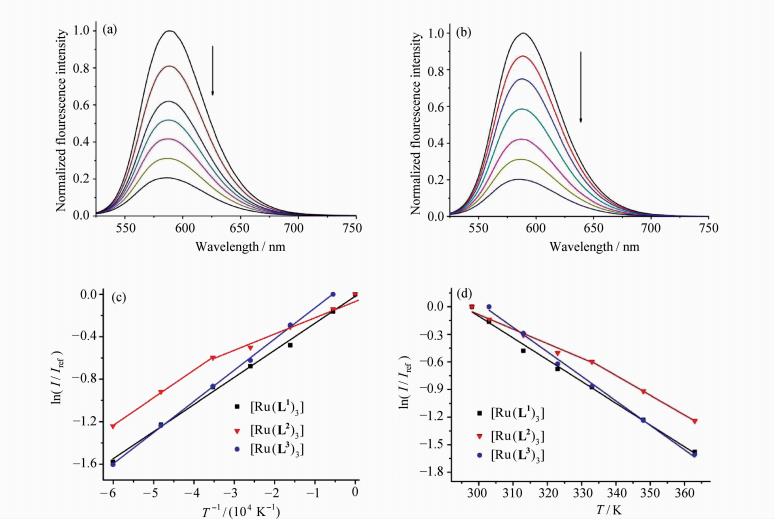在风洞和飞行器实验中,表面压力和温度的测定是了解飞行器气动力学性能和传热特性的最基本课题。传统的物体表面温度测定是在表面离散点安装温度传感器,如热电偶和电阻温度计进行测量[1]。20世纪80年代以来,研究者发展了一种基于发光温度猝灭原理的温敏漆(Temperature Sensitive Paints, TSP)测温技术[2, 3]。与传统测温方法相比,温敏漆测温技术提供了以非接触方式对复杂气动模型进行表面全域测量,以较低成本获得空间高分辨测量结果, 而且适用于大面积固体及运动物体的表面温度分布测量[3, 4]。近年来,温敏漆在液态流体、微通道、颗粒表面等领域也得到了广泛的应用[5, 6, 7]。
温敏漆的组成包括发光探针分子和聚合物基质两个部分,其中发光探针分子是温敏漆的核心[8]。温敏漆常用的发光探针包括多环芳烃化合物,如芘等有机染料[9],以及Eu、Pt、Ru等过渡金属的配合物[10, 11]。有机小分子的荧光寿命一般不超过20 ns。而金属配合物发光材料的金属-配体电荷转移激发态(Metal-Ligand Charge Transfer, MLCT)的发光寿命可达几百纳秒,甚至为毫秒级,且对环境的温度变化比较敏感,因此金属配合物在温敏发光材料中的应用受到了广泛关注[12]。Ru与联吡啶、邻菲罗啉、三联吡啶等配体形成的配合物具有较好的光、热、氧化-还原稳定性,因而在光电化学元件、太阳能电池、抗癌药物、非线性光学材料等领域得到了广泛的应用[13, 14, 15]。通过改变侧链基团,可以调控三联吡啶钌配合物的给电子和受电子特征及光物理过程,得到具有较高灵敏度的Ru类温敏探针分子[16]。本文合成了一系列咪唑[4, 5-f] -1,10-邻菲罗啉衍生物L1~L3,并进一步制备了相应的钌配合物(图1),研究了取代基对咪唑[4, 5-f] -1,10-邻菲罗啉钌配合物的光谱性质、温敏特性的影响。
 | 图1 配体及钌配合物的化学结构式 Chemical structures of the ligands and their corresponding Ru(Ⅱ) complexes |
1,10-邻菲罗啉5,6二酮(化合物1)[17],7-(溴乙氧基)-香豆素(化合物2)[18],以及咪唑[4, 5-f]-1,10-邻菲罗啉配体L1[19]分别参照文献合成。其余试剂均为分析纯,购自国药集团。所有有机溶剂经无水处理,使用前重蒸。所用水溶液均采用二次蒸馏水。
所用仪器:Hitachi U-3100紫外-可见吸收光谱仪,日本; Hitachi F-4600荧光分光光度,日本;Bruker Avance 400核磁共振波谱仪,德国。
1.2 配体L2的合成将配体L1(50 mg,0.227 mmol)和7-(溴乙氧基)-香豆素(化合物2)(73 mg,0.272 mmol)溶于 10 mL重蒸的DMF中,再加入碳酸铯(177 mg,0.543 mmol),25 ℃反应60 h,离心得白色沉淀。沉淀用水多次洗涤,60 ℃真空干燥24 h,得到白色沉淀50 mg,产率为54%。1HNMR(DMSO-d6,600 MHz):9.07~9.08(m,1H);9.03~9.04(m,1H),8.97~8.99(m,1H);8.86~8.88(m,1H);8.45(s,1H);7.93(d,1H, J=9.6);7.83~7.85(m,1H);7.78~7.82(m,1H);7.54(d,1H,J=9.0);6.93(m,1H);6.75~6.77(m,1H);6.26(d,1H,J=9.6);5.22~5.24(m,2H);4.62~4.63(m,2H)。
1.3 配体L3的合成将1,10-邻菲罗啉-5,6-二酮(0.40 g,1.90 mmol)和对甲苯胺(0.206 g,1.90 mmol)溶于10 mL冰醋酸中,再加入乙酸铵2 g(2 g,26.0 mmol)和0.2 g多聚甲醛,70 ℃反应48 h,得到酒红色溶液,除去溶剂后加入5%的碳酸氢钠溶液100 mL,用50 mL氯仿萃取3次。合并有机层,旋干后硅胶柱色谱分离(THF/CHCl3= 1/8,V/V,Rf= 0.50)。得到黄色固体0.33 g,产率55%。 1HNMR(CDCl3,600 MHz):9.17~9.18(m,1H);9.06~9.07(m,1H); 9.00~9.03(m,1H);8.02(s,1H);7.72~7.75(m,2H);7.44(s,4H);7.33~7.36(m,1H); 2.54(s, 3H)。
1.4 钌配合物的合成方法氯化钌(10.9 mg,0.0417 mmol)和配体L1~L3(0.2045 mmol)溶于10 mL乙醇-水混合溶液中(1/1,体积比),75 ℃反应48 h。将NH4PF6(0.163 g,10.0 mmol)溶于0.5 mL水后,滴加到上述反应液中,室温搅拌2 h,有红棕色沉淀生成。离心得沉淀,用水多次洗涤沉淀,60 ℃真空干燥24 h。
[Ru(L1) 3](PF6)2: 49.5 mg,产率为86%,1HNMR(DMSO-d6,600 MHz):9.04~9.22(d,2H);8.75(s,1H); 7.54~8.10(m,6H);6.76~6.85(m,2H);6.27(s,1H);5.32(m,2H); 4.66(m,2H)。MS (MALDI-TOF): [M-2PF6-H]+762.13,cacld for C39H24N12Ru,761.1。
[Ru(L2) 3] (PF6)2:50 mg,产率为62%,1HNMR(DMSO-d6,600 MHz):14.33(s,1H);8.97~9.01(m,1H);8.76(s,1H);8.04(d,2H,J=7.8 Hz);7.78(s,2H)。MS (MALDI-TOF):[M-PF6]+1471.2,cacld for C72H48N12O9RuPF6,1471.0。
[Ru(L3) 3](PF6)2:45.8 mg,产率84%,1HNMR(DMSO-d6,600 MHz):9.09~9.14(m,1H);8.77~8.80(m,1H); 7.96~8.11(m,2H);7.78~7.87(m,2H);7.65~7.70(m,2H);7.55~7.61(m,3H)。MS (MALDI-TOF):[M-PF6]+1163.5,cacld for C59H40N12RuPF6,1163.0。
1.5 膜的制备方法载玻片放入无水乙醇中超声清洗10 min,再放入浓硫酸与双氧水的混合液(体积比H2SO4/H2O2= 7/3)中超声清洗30 min,然后用去离子水反复冲洗,最后用氮气将玻璃基片吹干,放入丙酮中待用。取0.15 g聚甲基丙烯酸甲酯(PMMA)溶解于3 mL苯甲醚中,再加入1 mg钌配合物,超声溶解。利用注射器将溶液滴加到事先固定于匀胶机上的玻璃基片上,在3000 r/min下旋涂10 s成膜。镀膜后的玻璃基片在60 ℃下真空干燥过夜。
1.6 钌配合物在水溶液中的温敏性能测试常温条件下,将钌配合物的水溶液通入氩气除氧30 min后,用聚四氟乙烯盖子密封。升温速度为0.5 ℃/min,到达相应温度后保温5 min,再进行测量,激发波长为440 nm,扫描范围为525~750 nm。
2 结果与讨论 2.1 化合物的合成与联吡啶、邻菲罗啉等含氮配体相比,咪唑[4, 5-f][l, 10]邻菲罗啉具有更大的共轭芳香环,其配合物在生物传感器、发光指示剂等领域得到了广泛应用,但是在温敏漆中的应用还很少[20, 21]。在混合酸H2SO4/HNO3(2/1, 体积比)条件下,将邻菲罗啉氧化生成1,10-邻菲罗啉-5,6-二酮[17](图2)。1,10-邻菲罗啉-5,6-二酮在酸性条件下通过缩合反应生成咪唑[4, 5-f] -1,10-邻菲罗啉配体L1和L3。其中配体L1在碱性条件下进行烷基化反应,得到配体L2。在乙醇-水混合溶液中,利用无水氯化钌与配体(L1~L3)反应,合成得到相应钌配合物[Ru(L1)3]、[Ru(L2)3]和[Ru(L3)3]。利用1HNMR和MALDI-TOF质谱对样品进行了表征。
 | 图2 配体L1~L3的合成路线 Synthesis routes for the ligands L1-L3 |
图3给出了咪唑[4, 5-f]-l, 10-邻菲罗啉配体L1~L3及相应钌配合物在水溶液中的吸收光谱。可以看出, L1及L3在水溶液中的最大吸收波长为282 nm,可归属于咪唑[4, 5-f]-l, 10-邻菲罗啉的π→π*跃迁[22]。L2在284 nm处有一个强的吸收峰,在320 nm处有一个肩峰,其中320 nm处的肩峰为香豆素基团的特征吸收峰[23]。L1~L3与Ru(Ⅱ)配位后,配合物在λ< 350 nm有强吸收,可归属为金属离子微扰的配体内部IL吸收。同时配合物在380~460 nm处有新的吸收峰出现,可归属为金属到配体的电荷转移跃迁(MLCT)吸收峰。
 | 图3 (a)咪唑[4, 5-f]-l, 10-邻菲罗啉配体L1~L3及其(b)Ru配合物在水中的紫外吸收光谱 UV-Vis absorption spectra of (a) the imidazo[4,5-f]-1,10-phenanthroline ligands (10 μmol/L) and (b) their corresponding Ru(Ⅱ) complexes (10 μmol/L) in water |
配体L1和L2的荧光发射峰位于410 nm左右,而L3在406和495 nm处有两个荧光发射峰(表1)(图4a)。与Ru(Ⅱ)形成的配合物在590 nm左右有新的发射峰,可归属为金属到配体电荷转移(MLCT)激发态发光(图4b)。合成的3种Ru(Ⅱ)配合物的发光量子产率比较接近,约为0.09左右,其发光寿命在0.69~0.82 μs。较长的发光寿命说明钌配合物的发光主要来源于金属到配体的电荷转移跃迁(MLCT)的三重态。
| 表1 咪唑[4, 5-f]-1, 10-邻菲罗啉配体L1~L3及其Ru(Ⅱ)配合物在水溶液中的光物理性质 Photophysical properties of the ligiands L1-L3and the corresponding Ru complexes |
 | 图4 (a)咪唑[4, 5-f]-1, 10-邻菲罗啉配体L1~L3及其(b)Ru配合物在水中的归一化发光光谱图 Normalized fluorescence spectra of (a) the imidazo[4,5-f]-1,10-phenanthroline ligands (10μmol/L) (λex= 280 nm) and (b) their corresponding Ru(Ⅱ) complexes (10 μmol/L) (λex= 320 nm) in water |
聚甲基丙烯酸甲酯(PMMA)是常用的一种温敏漆高分子基质,将钌配合物与PMMA混合后制备成膜,可研究钌配合物的温敏性能[25]。与在溶液中的吸收光谱相比,咪唑[4, 5-f]-1, 10-邻菲罗啉钌配合物在PMMA膜中吸收光峰的精细结构消失,且在长波范围(500~700 nm)有吸收(图5a),说明钌配合物在PMMA中发生了聚集[26]。
 | 图5 咪唑[4, 5-f]-l, 10-邻菲罗啉Ru(Ⅱ)配合物在聚甲基丙烯酸甲酯(PMMA)膜中的(a)紫外可见吸收光谱和(b)发射光谱(λex= 440 nm) (a) UV-Vis absorption spectra and (b) emission spectra of Ru(Ⅱ) complexes in poly(methyl methacrylate) (PMMA) film |
钌配合物在PMMA膜中的发射光谱在590和663 nm附近有两个发射峰,其中590 nm处的峰与溶液中的发射峰位置相近,可归属为游离的钌配合物发射峰,而663 nm处的峰可归属为处于聚集状态的钌配合物的发射峰[27](图5b)。文献报道,芳香配体Ru(Ⅱ)配合物中的芳香环之间容易进行π-π堆积,因而易于发生聚集[28]。[Ru(L3)3]在663 nm处的发射峰较弱,而配合物[Ru(L1)3]和 [Ru(L2)3]在663 nm处的发射峰较强,表明[Ru(L3)3]在PMMA膜中的聚集程度要低于[Ru(L1)3]和 [Ru(L2)3]。
2.4 钌配合物在PMMA膜中的温敏性能分析图6a和6b分别为不同温度下[Ru(L1)3]和[Ru(L3)3]在PMMA膜中的发射光谱图。由图可知,随着温度的升高,钌配合物的发射峰强度逐渐减弱,而峰位不随温度变化。因此,以PMMA为漆基,咪唑[4, 5-f]-1, 10-邻菲罗啉钌配合物为探针分子的温敏漆在30~90 ℃温度范围内有温度猝灭效应。温度升高,涂层发光探针分子的热振动增加,有利于激发态以散热的方式失活,使无辐射失活速率大大升高,从而降低发光过程的量子产率[29, 30]。
 | 图6 (a)[Ru(L1)3]和(b)[Ru(L3)3]在PMMA膜中随温度变化的发射光谱利用Ru(Ⅱ)配合物的发射光强度变化求取(c)非辐射活化能Enr和(d)温度灵敏度(λex= 440 nm) The emission spectra of (a) [Ru(L1)3] and (b) [Ru(L3)3] in PMMA film under different temperature conditions.Calculation of (c) activation energy for the non-radiative process (Enr) and (d) temperature sensitivity (ST) by plotting of emission intensity of Ru(Ⅱ) complexes. The temperature is 303 K, 308 K, 313 K, 318 K, 323 K, 328 K, 333 K, 338 K, 343 K, 348 K, 353 K, 358 K, 363 K, respectively |
温敏漆的光物理原理由公式(1)所示[31]:

公式(1)中, Enr为无辐射过程活化能,R为摩尔气体常数,Tref为热力学参考温度。I(T)和I(Tref)分别为温敏漆在高温时及参考温度时的发光强度。由公式(1)可知,被测模型表面温度越高, 发光强度越小。利用ln[I(T)/I(Tref)]与1/T作图,并进行线性拟合,直线的斜率为Enr/R(图6c)。实验结果表明,在一定温度范围内,表面温度与相对发光强度满足公式(1)。
温敏漆的温度灵敏度(Temperature sensitivity, ST)可由公式(2)计算:

公式(2)中,IT和I(Tref)分别为温敏漆在高温时及参考温度时的发光强度,dT为温度差。为比较不同钌配合物的温敏性能,采用对数斜率d[ln(I/Iref)]/dT(公式2)可表征特定温度范围内钌配合物的温度灵敏度(图6d)。
根据公式(1)和(2)分别对30~60 ℃和60~90 ℃区间内温敏漆的发光强度作图,计算出非辐射活化能Enr和温度灵敏度ST,计算结果如表2所示。由表可知,钌配合物的非辐射活化能为13.0~37.0 kJ·mol-1,与目前应用于温敏漆的金属配合物的非辐射活化能Enr相当[3, 32]。在30~60 ℃和60~90 ℃区间内,Enr和温度灵敏度的绝对值的大小顺序均为[Ru(L3)3] >[Ru(L2)3]≈[Ru(L1)3],说明探针分子中取代基结构对钌配合物的温敏性能有较大影响。所合成钌配合物[Ru(L1)3]、[Ru(L2)3]和[Ru(L3)3]主要通过MLCT三重态进行发光,而钌配合物的三重态对环境变化比较敏感[12],这使得钌配合物具有良好的温敏性能。其中[Ru(L3)3]在测定范围内的温度灵敏度绝对值要明显高于联吡啶钌配合物(-0.93%)[33]及三联吡啶钌配合物(-1.34%)[2]的值,表明所合成钌配合物作为发光探针,在温敏漆领域具有潜在的应用前景。
| 表2 Ru(Ⅱ)配合物在PMMA中的无辐射过程活化能Enr(kJ·mol-1)及其温度灵敏度STa Activation energy for the non-radiative processes (Enr) and temperature sensitivity (ST) of Ru(Ⅱ) complexes in PMMA film |
发光染料的温敏性与化合物的聚集状态、化合物所处的环境(如极性、pH值)等有关。文献报道二氰亚甲基-4H-吡喃衍生物与聚(N-异丙基丙烯酰胺)(PNIPAM)连接得到的聚合物具有良好的温敏性能[34]。当温度升高时,PNIPAM在水溶液中发生线团-球体的相转变,使二氰亚甲基-4H-吡喃衍生物所处微环境的极性急剧下降,降低了二氰亚甲基-4H-吡喃衍生物的分子内电荷转移效率,因而减弱了二氰亚甲基-4H-吡喃衍生物的发光。为进一步了解本文所合成钌配合物的发光猝灭机理,对钌配合物在水溶液中的温敏性能进行了研究。钌配合物[Ru(L1)3]和 [Ru(L3)3]在水溶液中的发射峰均位于590 nm左右(图7a和7b),未发现钌配合物聚集体在663 nm处的发射峰,表明钌配合物在水溶液中的聚集程度较低。这些配合物的发光随着水溶液的温度升高而下降。通过作图计算出钌配合物在水溶液中的非辐射活化能Enr和温度灵敏度ST(图7c和7d)。结果表明,钌配合物在水溶液中和PMMA膜中的非辐射活化能Enr和温度灵敏度ST比较接近(表2),说明钌配合物在PMMA膜中的发光下降不是由于配合物的聚集或所处环境变化引起,主要是由于配合物分子的热振动随温度升高而加剧造成的。
 | 图7 (a)[Ru(L1)3]和(b)[Ru(L3)3]在除氧水溶液中随温度变化的发射光谱 利用Ru(Ⅱ)配合物的发射光强度变化求取(c)非辐射活化能Enr和(d)温度灵敏度ST(λex= 440 nm) The emission spectra of (a) [Ru(L1)3] (20 μmol/L) and (b) [Ru(L3)3] (20 μmol/L) in water under different temperature conditions Calculation of (c) activation energy for the non-radiative process (Enr) and (d) temperature sensitivity (ST) by plotting of emission intensity of Ru(Ⅱ) complexes. The temperature is 298 K, 303 K, 313 K, 323 K, 333 K, 348 K, 363 K, respectively |
本文成功制备了具有不同取代基的咪唑[4, 5-f]-1,10-邻菲罗啉Ru(Ⅱ)配合物。将这些Ru(Ⅱ)配合物作为发光探针分子,利用旋涂法制备成膜,获得温敏漆样品。紫外-可见吸收光谱和发射光谱表明Ru(Ⅱ)配合物在PMMA膜中有聚集作用,引入合适的取代基可以减弱Ru(Ⅱ)配合物的聚集。利用440 nm作为激发光源,3种Ru(Ⅱ)配合物在590 nm左右有较强的发射峰,并且随着温度的升高,Ru(Ⅱ)配合物的发射光强度减弱,说明3种Ru(Ⅱ)配合物具有良好的温敏性能。其中具有苯基取代的咪唑[4, 5-f]-1,10-邻菲罗啉Ru(Ⅱ)配合物表现出最好的温度灵敏度ST,其ST值要高于已用于温敏漆的联吡啶Ru(Ⅱ)配合物和三联吡啶Ru(Ⅱ)配合物,说明对咪唑[4, 5-f]-1,10-邻菲罗啉配体结构进行合适的修饰,有望提高Ru(Ⅱ)配合物的温敏性能。
| [1] | Moffat R J. Some experimental methods for heat transfer studies[J]. Experimental Thermal and Fluid Science, 1990, 3(1): 14-32. |
| [2] | Liu T, Sullivan J P. Pressure and Temperature Sensitive Paints[M]. Berlin: Springer, 2004. |
| [3] | Liu T, Campbell B, Sullivan J P. Heat transfermeasurement on a wave rider at Mach 10 using fluorescent paint[J]. Journal of Thermophysics & Heat Transfer, 1994, 9(4): 605-611. |
| [4] | Liu T, Woodiga S. Feasibility of global skin friction diagnostics using temperature sensitive paint[J]. Measurement Science & Technology, 2011, 22(11): 115402-115412. |
| [5] | Costantini M, Fey U, Henne U, Klein C. Nonadiabatic surface effects on transition measurements using temperature-sensitive paints[J]. AIAA Journal, 2015, 53(5): 1172-1187. |
| [6] | Huang C, Li C, Wang H, Liou T. The application of temperature-sensitive paints for surface and fluid temperature measurements in both thermal developing and fully developed regions of a microchannel[J]. Journal of Micromechanics and Microengineering, 2013, 23(3): 37001-37007. |
| [7] | Asai K, Kanda H, Kunimasu T. Boundary-layer transition detection in a cryogenic wind tunnel using luminescent paint[J]. Journal of Aircraft, 1997, 34(1): 34-42. |
| [8] | 程 果, 魏长平, 任晓明, 王 贺. 新的稀土Eu,Tb(Ⅲ)β-二酮三元配合物的合成与光谱性质[J]. 中国稀土学报, 2012, 30(2):157-162. Cheng G, Wei C P, Ren X X, Wang H. Synthesis and photoluminescence properties of neweuropium,terbium(Ⅲ) ternary complexes based on diketone[J]. Journal of the Chinese Society of Rare Earths, 2012, 30( 2) : 157-162. |
| [9] | Sakaue H, Kuriki T, Miyazaki T. A temperature-cancellation method of pressure-sensitive paint on porous anodic alumina using 1-Pyrenesulfonic acid[J]. Journal of Luminescence, 2012, 132(2): 256-260. |
| [10] | Egami Y, Matsuda Y, Yamaguchi H, Niimi T. Property changes of temperature-sensitive paint immobilized in acry-lic polymer matrices[J]. Sensors and Actuators B, 2014, 195(5): 677-681. |
| [11] | Kose M E, Carroll B F, Schanze K S. Preparation and spectroscopic properties of multiluminophore luminescent oxygen and temperature sensor films[J]. Langmuir, 2005, 21(20): 9121-9129. |
| [12] | Stich M I J, Wolfbeis O. Fluorescence sensing and imaging using pressure-sensitive paints and temperature-sensitive paints[J]. Springer Series on Fluorescence, 2008, 5: 429-461. |
| [13] | Xie Y, Huang H, Yao J, Lin G, Jiang G, Liu Y. DNA-binding, photocleavage, cytotoxicity in vitro, apoptosis and cell cycle arrest studies of symmetric ruthenium(Ⅱ) complexes[J]. European Journal of Medicinal Chemistry, 2013, 63(5): 603-610. |
| [14] | Coe B J. Developing iron and ruthenium complexes for potential nonlinear optical applications[J]. Coordination Chemistry Reviews, 2013, 257(9-10): 1438-1458. |
| [15] | 夏 虹, 张成波, 刘晓冬, 阚士董, 马於光, 沈家骢.Ru(bpy)32+聚电解质光致发光电致发光性质[J]. 发光学报,2004, 25(1): 44-45. Xia H, Zhang C B, Liu X D, Kan S D, Ma Y G, Shen J C. Characteristic of photoluminescence and electroluminescence based on tris(bipyridyl) ruthenium(Ⅱ) doped polyelectrolytes[J]. Chinese Journal of Luminescence, 2004, 25(1): 44-45. |
| [16] | Campbell B, Liu T, Sullivan J P. Temperature sensitive fluorescence paint systems[C]. In: 18th AIAA Aerospace Ground Testing Conference. Colorado: Springs, 1994. AIAA 94-2483. |
| [17] | Paw W, Eisenberg R. Synthesis, characterization, and spectroscopy of dipyridocatecholate complexes of platinum[J]. Inorganic Chemistry, 1997, 36(11): 2287-2293. |
| [18] | Rullens F, Vuillaume P Y, Moussa A, Habib-Jiwan J, Laschewsky A. Ordered polyelectrolyte "multilayers". 7. hybrid films self-assembled from fluorescent and smectogenic poly(diallylammonium) salts and delaminated clay[J]. Chemistry of Materials, 2006, 18(13): 3078-3087. |
| [19] | Wu J, Ye B, Wang L, Ji L, Zhou J, Li R, Zhou Z. Bis(2,29-bipyridine)ruthenium(Ⅱ) complexes with imidazo[4,5-f][1,10]-phenanthroline or 2-phenylimidazo[4,5-f][1,10]phenanthroline[J]. Journal of Chemical Society, Dalton Transactions, 1997, 8: 1395-1401. |
| [20] | Li S, Zhang C, Huang S, Hu F, Yin J, Liu S H. Highly selective colorimetric and fluorescent sensors for the fluoride anion based on imidazo[4,5-f]-1,10-phenanthroline metal-complexes[J]. RSC Advances, 2012, 2(10): 4215-4219. |
| [21] | Liu Y, Duan Z, Zhang H, Jiang X, Han J. Selective bin-ding and inverse fluorescent behavior of magnesium ion by podand possessing plural imidazo[4,5-f]-1,10-phenanthroline groups and its Ru(Ⅱ) complex[J]. Journal of Organic Chemistry, 2005, 70(4): 1450-1455. |
| [22] | 高云燕, 曹 璐, 欧植泽, 陈 晨, 李 嫕, 王雪松. 联吡啶[3,2-a:2',3-c]-7-氮杂-吩嗪铜(Ⅰ)配合物的合成、表征及其与DNA的相互作用[J]. 物理化学学报, 2013, 29(10): 2162-2172. Gao Y Y, Cao L, Ou Z Z, Chen C, Li Y, Wang X S. Synthesis and characterization of a Cu(Ⅰ) complex of dipyrido[3,2-a:2',3-c]-7-aza-phenazine and its interaction with DNA[J]. Acta Physico-Chimica Sinica, 2013, 29(10): 2162-2172. |
| [23] | Feng P, Zhu J, Cheng Z, Zhang Z, Zhu X. Reversible addition-fragmentation chain transfer polymerization of 7-(4-(acryloyloxy)butoxy)coumarin[J]. Polymer, 2007, 48(20): 5859-5866. |
| [24] | Holzer W, Gratz H, Schmitt T, Penzkofer A, Costela A, Garcia-Moreno I, Costela A, Sastre I R, Duarte F J. Photo-physical characterization of rhodamine 6G in a 2-hydroxyethyl-methacrylate methyl-methacrylate copolymer[J]. Chemical Physics, 2000, 256(1): 125-136. |
| [25] | 宋亚娇,孙 晶,闫玲玲,朱 鹏,于文生,李 剑. Eu0.5La0.5(TTA)3/PMMA温敏漆的制备及性能研究[J]. 中国稀土学报, 2013, 31(1): 55-59. Song Y J, Sun J, Yan L L, Zhu P, Yu W S, Li J. Preparation and properties of temperature sensitive paint[J]. Journal of the Chinese Society of Rareearths, 2013, 31(1): 55-59. |
| [26] | Chen Y, Xu W, Kou J, Yu B, Wei X, Chao H, Ji L. Aggregation-induced emission of ruthenium(Ⅱ) polypyridyl complex[Ru(bpy)2(pzta)]2+[J]. Inorganic Chemistry Communications, 2010, 13(10): 1140-1143. |
| [27] | Jagassar P S, Perri A, Ibarrola G, Gafney H D. Ligand initiated self-assembly of Pt and Ir nanoparticles about Ru(Ⅱ) diimines in room temperature fluid solution[J]. Journal of Physical Chemistry C, 2013, 117(4): 1925-1934. |
| [28] | Campagna S, Giannetto A, Serroni S, Denti G, Truso S, Mallamace F, Micali N. Aggregation in fluid solution of dendritic supermolecules made of Ruthenium(Ⅱ)- and Osmium(Ⅱ)-polypyridine building blocks[J]. Journal of the American Chemical Society, 1995, 117(6): 1754-1758. |
| [29] | 吴世康. 超分子光化学导论[M]. 北京: 科学出版社,2005. 24-37. Wu S K. An Introduction to Supramolecular Photochemistry[M]. Beijing: Science Press, 2005. 24-37. |
| [30] | 张建成,马金石. 现代光化学[M]. 北京: 化学工业出版社, 2006. 19-46. Zhang J C, Ma J S. Modern Photochemistry[M]. Beijing: Chemical Industry Press, 2006. 20-45. |
| [31] | 宋亚娇, 孙 晶, 朱 鹏, 闫玲玲, 李 剑. 稀土钇掺杂Eu(TTA)3/PMMA温敏漆的制备及性能分析[J]. 无机化学学报, 2013, 29(6): 1171-1175. Song Y Q, Sun J, Zhu P, Yan L L, Li J. Preparation and properties of rare earth Yttrium doped Eu(TTA)3/PMMA temperature sensitive paint[J]. Chinese Journal of Inorganic Chemistry, 2013, 29(6): 1171-1175. |
| [32] | Gouin S, Gouterman M. Ideality of pressure-sensitive paint. Ⅱ. effect of annealing on the temperature dependence of the luminescence[J]. Journal of Applied Polymer Science, 2000, 77(13): 2805-2814. |
| [33] | Liu T, Sullivan J P. Heat transfer and flow structures in an excited circular impinging jet[J]. International Journal of Heat & Mass Transfer, 1996, 39(17): 3695-3706. |
| [34] | Guo Z, Zhu W, Xiong Y, Tian H. Multiple logic fluorescent thermometer system based on N-isopropyl methacry-lamide copolymer bearing dicyanomethylene-4H-pyran moiety[J]. Macromolecules, 2009, 42(5): 1448-1453. |




